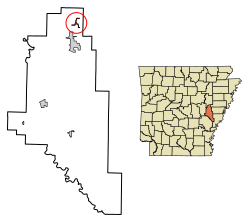Fargo, Arkansas facts for kids
Quick facts for kids
Fargo, Arkansas
|
|
|---|---|

Location in Monroe County, Arkansas
|
|
| Country | United States |
| State | Arkansas |
| County | Monroe |
| Area | |
| • Total | 0.47 sq mi (1.23 km2) |
| • Land | 0.46 sq mi (1.18 km2) |
| • Water | 0.02 sq mi (0.04 km2) |
| Elevation | 200 ft (60 m) |
| Population
(2020)
|
|
| • Total | 57 |
| • Density | 124.73/sq mi (48.13/km2) |
| Time zone | UTC-6 (Central (CST)) |
| • Summer (DST) | UTC-5 (CDT) |
| ZIP code |
72021
|
| Area code(s) | 870 |
| FIPS code | 05-23140 |
| GNIS feature ID | 2406490 |
Fargo is a small town in Monroe County, Arkansas, United States. In 2020, its population was 57 people. This was a decrease from 98 people in 2010.
Contents
History of Fargo
Railroads were very important in the late 1800s. They were being built all over Arkansas. By 1898, two major railroad lines crossed paths. One was the St. Louis Southwestern Railway. The other was the Missouri and North Arkansas Railroad (M&NA).
A post office named Fargo was set up at this railroad crossing. However, it was not yet a town. In 1911, the two railway companies built a train station, called a depot, in Fargo. Many settlements grew along the M&NA railroad as it was built. Fargo was one of them. Leroy Mahon owned the land where the railroads crossed.
How Fargo Became a "Freedmen's Town"
Leroy Mahon planned out the land for a new settlement. He created a place for Black families to live. This type of community was known as a freedmen's town. These towns were built by or for African Americans who had been freed from slavery.
Leroy Washington Mahon was born into slavery in 1861. His original last name was Stenhouse. After slavery ended, his family worked as sharecroppers. In 1888, Leroy and his brother Tom moved to Monroe County, Arkansas. They were looking for better chances in life. Around 1900, Leroy changed his last name to Mahon. In 1911, he divided 40 acres of his farmland into plots. Black homeowners bought these plots and built their homes there.
The first churches in Fargo were First Baptist and Bethel Presbyterian.
In 1920, Floyd B. Brown started the Fargo Agricultural School. Students came to this school from all over Arkansas. The school also received money from people outside of Arkansas. The school helped the Fargo community in many ways. They helped pave the muddy roads. They also brought electricity and telephone service to the town. The school held a yearly meeting for farmers. Hundreds of farmers came to share ideas and learn new things.
Geography of Fargo
Fargo is located in the northern part of Monroe County. It is along U.S. Route 49. This road goes south 4 miles to Brinkley. It goes north 8 miles to Hunter. Interstate 40 is about 3 miles south of Fargo. You can get to it from Exit 216 (US 49).
The town has a total area of about 0.47 square miles. A very small part of this area, about 0.02 square miles, is water.
Population Changes in Fargo
The population of Fargo has changed over the years.
- In 1990, there were 140 people.
- In 2000, the population was 118.
- In 2010, it was 98 people.
- By 2020, the population had decreased to 57 people.
In 2000, there were 118 people living in Fargo. There were 41 households and 31 families. The average household had almost 3 people. The average family had over 3 people.
Notable People from Fargo
The actress and comedian Sasheer Zamata has a special connection to Fargo. She is the great-granddaughter of Leroy Mahon, who helped create the town. This family connection was discovered on a TV show called Finding Your Roots with Henry Louis Gates Jr.. The episode aired on January 7, 2020.
See also
 In Spanish: Fargo (Arkansas) para niños
In Spanish: Fargo (Arkansas) para niños

